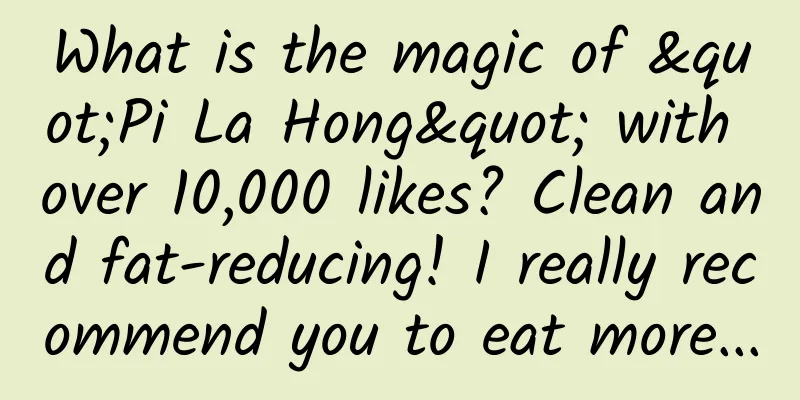What is the magic of "Pi La Hong" with over 10,000 likes? Clean and fat-reducing! I really recommend you to eat more...

|
Recently, a cold dish on a social platform has become quite popular, easily getting over 10,000 likes, and countless people checking in and submitting homework in the comment area. Friends in Xinjiang must have felt familiar with "primary school classmates on TV" when they saw it. Isn't this the "Pi La Hong" (also called "Tiger Vegetable") that we have eaten since childhood? Mom would make it when she had no appetite. Is this cold dish really so "magical"? Let's talk about it today. Image from Xiaohongshu Onions, green peppers, tomatoes All nutrition is excellent Let's start with the name of this dish. It's called "Pi La Hong" because Xinjiang people call onions "Pi Ya Zi", "La" means green pepper, and "Hong" means tomatoes. The specific steps are as follows: 1. Cut half a tomato, half an onion and 1 green pepper into shreds and set aside. 2. Soak the onions in water for 1 to 2 hours, or rinse them 5 to 8 times to remove the spicy taste of the onions as much as possible. 3. Mix the three ingredients together, add half a spoon of salt, 2 spoons of light soy sauce, 1 spoon of aged vinegar, 1 spoon of sugar, and 1 spoon of sesame oil, and mix well. It tastes super refreshing and relieves greasiness. A quick look at these three ingredients will tell you that this dish may not be simple. After all, each ingredient alone is very nutritious. Onions are known as the "Queen of Vegetables" and "Heart Stent". A large number of studies at home and abroad have shown that onions have powerful antioxidant and anti-inflammatory effects. They can not only help regulate blood lipids and blood pressure, protect cardiovascular system, but also have anti-cancer effects. This is mainly due to the various phytochemicals with antioxidant effects that are rich in onions. For example, flavonoids in onions, especially quercetin and kaempferol, have significant antioxidant and anti-inflammatory effects. Quercetin has been used as an adjuvant treatment for hypertension, hyperlipidemia, and coronary heart disease, and has shown potential in clearing senescent cells. New research in 2024 also revealed the potential application of quercetin in anti-tumor and type 2 diabetes treatment. The spicy taste of onion comes from its sulfur-containing compounds, which have antibacterial and anti-inflammatory effects, and can regulate insulin function, lower blood sugar, regulate cholesterol metabolism, and inhibit lipid synthesis and platelet aggregation. In addition, onions contain steroidal saponins, such as furostanol and spirostanol glycosides, which have antioxidant, free radical damage reduction, cholesterol-lowering and anti-inflammatory effects in the body. The selenium content of onions is 0.92 micrograms per 100 grams, which is not the highest, but much higher than some vegetables, such as Chinese cabbage and broccoli (0.57 micrograms per 100 grams for the former and 0.43 micrograms per 100 grams for the latter). Selenium helps reduce oxidative stress and plays an antioxidant, anti-inflammatory, anti-aging and cardiovascular disease prevention role. If you use purple onions, which contain a considerable amount of anthocyanins, they can also have antioxidant and anti-inflammatory effects. "Pi La Hong". Copyrighted image from the photo library. Reproduction and use may cause copyright disputes. An onion alone is so powerful, not to mention tomatoes and green peppers. The vitamin C content of different varieties of tomatoes is about 10-33 mg/100 g . The ones with higher content can be compared with fruits such as tangerines and oranges. At the same time, tomatoes have an advantage that other vegetables and fruits do not have, that is, lycopene. Lycopene has a very strong antioxidant capacity, which is 100 times that of vitamin E. Let's talk about the green pepper, which seems to be a "supporting role". In fact, it is the low-key "champion" of vitamin C content among vegetables , with a content of up to 130 mg/100 g, which is 6 times that of lemon (22 mg/100 g)! There is no need to say much about the antioxidant effect of vitamin C. It can not only resist oxidation by itself, but also work synergistically with many other antioxidant ingredients. Now you understand why this dish is so great! The three raw materials all have certain antioxidant effects; and in terms of fat loss, onions alone can effectively promote fat metabolism, not to mention that tomatoes and green peppers are typical low-calorie foods, the former only 15 kcal/100 g, and the latter only 18 kcal/100 g, which is comparable to the calories of Chinese cabbage, rapeseed, and cucumber. Even though the calories in this dish are not much, the fat and cholesterol are metabolized faster. In addition, the dietary fiber in the three vegetables takes up the stomach capacity, so the subsequent food intake will also be reduced. As long as you pay a little attention to the fat and sugar content of other foods, and eat this spicy red dish regularly, it will be easy to lose weight. If you are worried about the problem of onions irritating your mouth and eyes, as well as bad breath after eating, you can try the following methods: First, if you are afraid of onions irritating your eyes, you can put them in the refrigerator or freeze them for a while before cutting them , which will reduce the activity of alliinase, which can decompose sulfur compounds and release pungent odors, and make them unable to work, so that they will not be so irritating to the eyes. Another way is to pour more water on the knife when cutting onions . This is to use the characteristics of pungent odor molecules that are easily soluble in water to reduce the concentration in the air and reduce the attack on the eyes. Secondly, if you are worried about the spicy taste of onions, you can choose yellow or white onions, which are milder than purple onions and suitable for cold dishes. For those who really can't tolerate it, you can also blanch the onion shreds in boiling water for 10-15 seconds. This will not affect the taste too much, and it can also remove some sulfur compounds and reduce the spicy taste. Third, after eating onions, you can drink some milk, eat some apples or lettuce, chew some tea leaves, or brush your teeth and clean your tongue in time to neutralize, decompose or clean up the odor caused by sulfur compounds. It works! If you want this dish to be more delicious and healthier, be careful not to put too much salt and oil when making it (pouring hot oil or mixing with sesame oil counts). You can also add some thin slices of apple or pear into it. It will be crispy and sweet without destroying the original flavor of the cold dish. It is worth a try. "Personalized customized version" Although "Pi La Hong" has many benefits, some friends may not be used to the taste of onions, or do not like one or more of these three ingredients. Are there any alternative ingredients that also have anti-inflammatory, antioxidant and fat-reducing effects? A must have. Friends who don’t like tomatoes can replace them with carrots or broccoli . The former is rich in carotenoids, and the latter not only has a high vitamin C content, but also contains sulforaphane, which has a good antioxidant effect. If you don’t like green peppers, you can use celery or lettuce instead. Celery contains apigenin and luteolin, both of which have good anti-inflammatory and antioxidant effects; lettuce is rich in polyphenols and anthocyanins, and its antioxidant effect should not be underestimated. If you really can't get used to eating onions, you can replace them with purple cabbage. Purple cabbage is rich in vitamin C and anthocyanins, and has a great antioxidant effect. But I still want to suggest that you should not replace onions . After all, it is really comprehensive! Now you don’t have to worry, right? By making good use of fresh vegetables, we can completely add more anti-inflammatory cold dishes to “Pi La Hong” and make various renovations, so that it is easy to make a different dish every week. By the way, one last reminder: this kind of salad is best eaten right after it is made, and should not be kept overnight to avoid spoilage or an increase in nitrite content. If you really can't finish it, you can divide a portion in advance, seal it with plastic wrap, and refrigerate it, and try to finish it the next day. References [1]HUANG H, LIAO D, DONG Y, et al. Effect of quercetin supplementation on plasma lipid profiles, bloodpressure, and glucose levels: a systematic review and meta-analysis [J]. Nutr Rev, 2020, 78(8): 615-626. [2]LIU HH, WANG Y, TONG J, et al. Quercetin analogs as α-glucosidase inhibitors with antidiabetic activity[J]. Food Bioscience, 2024, 58: 103713. [3]Di Micco R, Krizhanovsky V, Baker D, d'Adda di Fagagna F. Cellular senescence in ageing: from mechanisms to therapeutic opportunities. Nat Rev Mol Cell Biol. 2021 Feb;22(2):75-95. [4]WANG Q, MA C, WANG N, et al. Effects of quercetin on the DNA methylation pattern in tumor therapy: an updated review[J]. Food & Function, 2024, 15: 3897. [5]Elnima EI, Ahmed SA, Mekkawi AG, Mossa JS. The antimicrobial activity of garlic and onion extracts. Pharmazie. 1983 Nov;38(11):747-8. [6]Cg, Sheela and KT Augusti. "Antidiabetic effects of S-allyl cysteine sulphoxide isolated from garlic Allium sativum Linn." Indian journal of experimental biology 30 6 (1992): 523-6. [7]Professor Eric Block. The Organosulfur Chemistry of the Genus Allium-Implications for the Organic Chemistry of Sulfur[J]. Angewandte Chemie International Edition in English Volume 31, Issue 9 p. 1135-1178. [8] Yoshinori Itokawa, Kikuko Inoue, Sukenari Sasagawa. Effect of S-Methylcysteine Sulfoxide, S-Allylcysteine Sulfoxide and Related Sulfur-containing Amino Acids on Lipid Metabolism of Experimental Hypercholesterolemic Rats[J]. The Journal of Nutrition, 1973, 103(1)88-92. [9] Yu Jing, Wen Rongxin, Yan Qingxin. Research progress on active substances and physiological functions of Allium plants[J]. Food Science, 2020, 41, 7: 255-265. [10] Yang Yuexin. Data Table of Basic Compositions of Chinese Functional Food Ingredients[M]. China Light Industry Press. Beijing, 2013: 370. [11] Tan Zhixin, Li Yushan. Research progress on the antioxidant effect of selenium[J]. Modern Preventive Medicine, 2003, 6, 34. [12] Yang Yuexin. Standard Edition of Chinese Food Composition Table (6th Edition). Beijing: Peking University Medical Press, 2019. Planning and production Author: Wang Lu, registered dietitian Review丨Zhang Yu, researcher/PhD, Chinese Center for Disease Control and Prevention, national health science expert Planning丨Yang Yaping Editor: Yang Yaping Proofread by Xu Lailinlin |
>>: Why can't humans grow and replace teeth infinitely like sharks?
Recommend
How QQ and WeChat platforms create aggregators of users’ scattered information!
There is no doubt that WeChat and QQ have become ...
What does "starting with an egg" mean? This is called native advertising!
When doing information flow advertising , the mos...
After trying out the mini-app, I found that Android users finally crushed Apple fans
In order to reflect Zhang Xiaolong's understa...
Snow accumulation in the south exceeds that in the northeast? Big data reveals the top ten cities with the heaviest snow in my country
There is no winter without snow! From ancient tim...
Scientific answers: What is the time dilation effect of relativity, and can it make people immortal?
Yesterday, I published an article introducing the...
The automatic traffic diversion method of WeChat Official Account 4.0 makes it easy for beginners to get started and reach 500+ followers per day
The automatic traffic diversion method of WeChat ...
Cold start operation skills of Douyin account
“It’s hard to create a new Douyin account now!” R...
E-commerce operations: Marketing planning to create hot products
What is a hot item? Simply put, it is the best-se...
Where did the budget go? How to define new users of investment and financial management?
I don’t know whether you readers usually look at ...
Google makes mistakes too: Four Android features that failed miserably
[[127442]] While the major features that Google p...
How to balance security and performance? Exploration and practice of HTTPS optimization for e-commerce websites
[51CTO.com original article] As we all know, duri...
Mr. Crab · Douyin short video is a good recommendation, super suitable for beginners, teach you how to quickly monetize on Douyin
Mr. Crab · Douyin short video is a good recommend...
It’s called wheat but it’s not actually wheat. The nutritional value of this ingredient is excellent!
If you have experience in losing weight or exerci...
New discovery! The largest known explosion in the universe has not stopped for 3 years
Xinhua News Agency, Beijing, May 12th. Astronomer...
With Huawei and Xiaomi in front and OV and Meizu behind, how long can Liu Zuohu's OnePlus last?
Recently, OnePlus released this year's flagshi...









